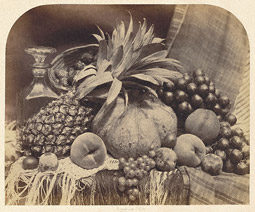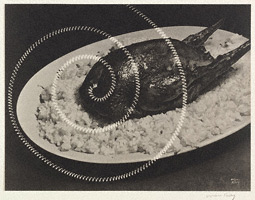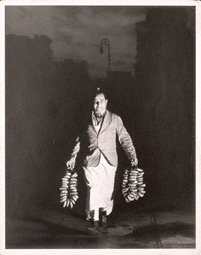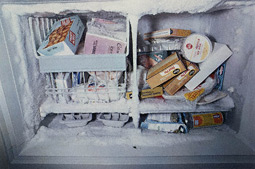 |
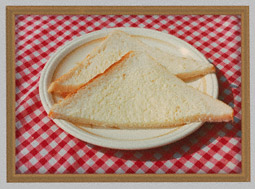
 |
 |
Untitled from British Food, Martin Parr, 1995. © Martin Parr/Magnum Photos
|
 |
Food, from basic sustenance to savory repasts, awakens the senses. Drawn from the J. Paul Getty Museum's collection, this exhibition provides an overview of photographers' responses to this rich subject. Spanning the period from the mid-19th century until today, the images highlight important technological and aesthetic innovations as well as matters of taste.
Several photographs in the exhibition are recent acquisitions on view for the first time, including works by Martin Parr and Taryn Simon.
|
 |
|
In the 19th century, photographers' approach to the representation of food was predominantly influenced by the genre of still life painting.
This lush display of exotic fruits, dominated by a pineapple with its leafy crown, demonstrates Roger Fenton's mastery of lighting and composition. It remains remarkably tantalizing a century and a half after he photographed it. A man of diverse interests, Fenton first studied literature, then law, and finally painting before taking up photography in 1851.
Photography came to be accepted as a legitimate medium with which to create works of art—and not just scientific documents—in part because of images such as this one.
|
 |
|
During the first half of the 20th century, many photographers embraced the unique expressive potential offered by the mechanical eye of the camera. Strong diagonals, the repetition of form, tight cropping, and close-up views lent dynamism to everyday foods.
Man Ray incorporated the cameraless photogram process while enlarging this image of a roasted chicken. By placing a coiled spring atop the sheet of photographic paper during the exposure, he created a spiral that suggests both the heating element of an oven and a world modernized by electricity.
In the late 1920s, when private utility companies in Paris were actively competing for middle-class customers, one company took the bold step of commissioning Man Ray to create a portfolio of ten images to promote domestic uses of electricity.
|
 |
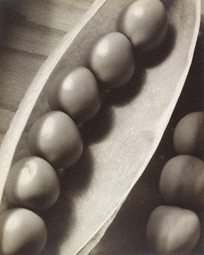
 |
 |
Peas in a Pod, Edward W. Quigley, about 1935
|
 |
 |
Edward W. Quigley implemented strong lighting from the left, a diagonal spanning from top right to bottom left, and tight cropping to create this composition, which is at once remarkably tactile and abstract. Six peas in a pod are transformed here into solid spheres cradled by the translucent curves of their shell.
Born and raised in Philadelphia, Quigley opened a commercial studio in 1930. Supporting himself with advertising and editorial work, he embarked on a number of experiments with light and composition that were very much influenced by Modernist concerns of the day.
|
 |
|
Throughout the 20th century, numerous photographers incorporated images of food into larger bodies of work that describe a specific time, place, or culture. Their recording of foodstuffs in stores or at home provides insight into social customs and the roles played by marketing and consumerism in promoting specific lifestyles that revolve around nourishment.
Published in Weegee's People (1946), this photograph of Max the bagel man demonstrates Weegee's sensitive, gregarious side. The Austrian-born immigrant trolled New York from late night to early morning, attempting to capture the essence of life in the city in the 1930s and 1940s.
The image counters Weegee's penchant for dark sensationalism with his deep love of the city—and that moment just before sunrise when the freshest bagels in town are delivered.
|
 |
|
William Eggleston adopted a casual, snapshot-like style when focusing his 35mm camera on the most ordinary, even banal, objects and situations to create unexpected, compelling compositions.
At first glance, this freezer compartment packed with TV dinners, Tasty Taters, beef pies, creamed spinach, and vanilla ice milk offers the promise of immediate gratification from a quickly prepared meal. The inclusion of ice-encrusted walls and adjectives announcing "artificially flavored" foods, however, transforms that promise into the compromise of convenience.
|
 |
 |
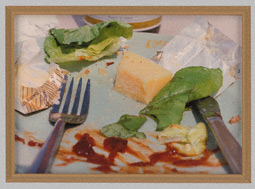
 |
 |
Untitled from British Food, Martin Parr, 1995. © Martin Parr/Magnum Photos
|
 |
Works by contemporary photographers often draw our attention to larger social concerns, enabling their makers to straddle the worlds of photojournalism and fine art.
The 24 photographs in Martin Parr's British Food series present a sampler of meals and snacks enjoyed by a country notoriously derided for its dearth of sophisticated cuisine.
Defining photography as a form of collecting, Parr began amassing all manner of things at a very young age. Featuring his own photographs as well as his collections of postcards, photographic books, and pop-culture objects, his numerous publications describe a unique Parrworld (one of his titles).
In the British Food series and his other work, Parr probes leisure, consumerism, and mass tourism to reveal underlying national characteristics and idiosyncrasies.
|
 |

